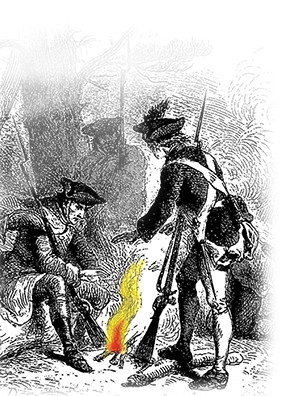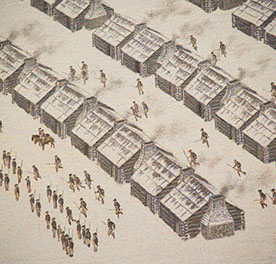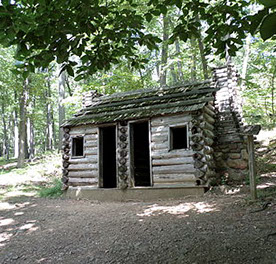

The Winter at Jockey Hollow
During the Winter of 1779–1780, the Wick family housed General Arthur St. Clair, who was then commander of the Pennsylvania Line, and several of his aides.
On October 17, 1779, the entire Continental Army, consisting of 13,000 men, encamped for the winter at Jockey Hollow. Soldiers camped at this location until June 1780, during which time they endured some of the harshest conditions of the war. In the days of horsepower, this was considered an impregnable redoubt. Another reason why the location was chosen was because the surrounding area held citizens, like the Wick family, who were the strongest patriots in the region and the most sympathetic to the rebel cause. The region was also home to many Huguenots, like Joshua Guerin, whose house is still preserved at the Park, but is inaccessible to Park visitors.
The Winter at Jockey Hollow was the worst winter of the war, even worse than the Winter at Valley Forge two years before. Twelve men often shared one of over one thousand simple huts built in Jockey Hollow to house the Army. Desertions were frequent. The entire Pennsylvania Line successfully mutinied, and later 200 New Jersey soldiers attempted to emulate them. Several of the ringleaders of the latter were hanged.
Army encampment
Strategically, the Wicks were considered by the officers of the Continental Army to be one of the most reliable and patriotic families in America, so the Army never had any trouble quartering there, nor did the Wick family ever require compensation for the use of their land, which was especially important to Congress. The Continental Army had wintered there in 1776-77 following George Washington's crossing of the Delaware River and the subsequent American victories at Trenton and Princeton. One fourth of the Army died from smallpox or dysentery. During that Winter, the Wicks hosted Captain Joseph Bloomfield.
Jockey Hollow had hosted prominent officers before the winter of 1779–1780. Alexander Hamilton was likely quartered at the Wick House at least once during the War. The Wicks would use one side of the house, and gave the other to the officers who were quartered with them, and the Wicks would share the kitchen and dining room with the officers.
Soldier housing
Reconstructed hut at Jockey Hollow (July 2015)
Soldiers had to build their own huts including surrounding trenches for drainage. The huts, made of log, were 14 by 16 feet (4.3 by 4.9 m) and 6.5 feet (2.0 m) high. Twelve men often shared one of over one thousand simple huts built in Jockey Hollow to house the army. Inside the huts soldiers had a fireplace for warmth and cooking. To create a floor they packed the ground for an earthen floor. Soldiers also had to make their own furniture, including bunks and tables. Their bunks got covered with straw and each soldier was given one blanket. Soldiers huts were about 2 to 3 ft (50–100 cm) apart, with three rows of eight huts for each regiment. By 1780, soldiers had built about 1,200 huts in Jockey Hollow.
Several monuments are dedicated and built over the mass graves of the soldiers who died at Jockey Hollow.


HOME PAGE
Courtesy of Wikipedia®
Information was last edited on 2 February 2023

